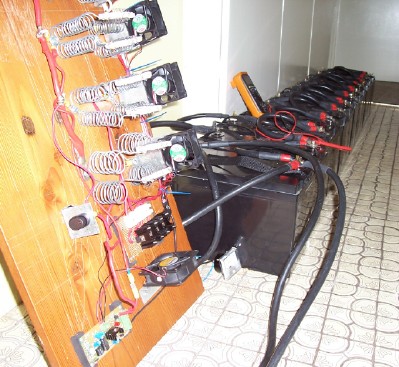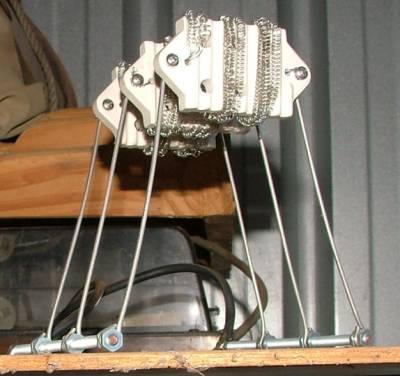
|

|
Forum Index : Windmills : Dummy load suggestion.
| Page 1 of 2 |
|||||
| Author | Message | ||||
| KiwiJohn Guru Joined: 01/12/2005 Location: New ZealandPosts: 691 |
We have seen a couple of people in just the last few days asking questions that are difficult to give any useful response to without more information. So I am thinking that if we were to design a standard "Back Shed Dummy Load" we could help people like this to make progress. My idea is that we develop some sort of readily repeatable design that we can duplicate as needed to get a basic feel for what is required. To kick off here are two basic designs, firstly some repeatable array of automotive lights (head lamp units and smaller bulbs in a 'standard' configuration) and a resistive element such as from an old clothes dryer. What does anyone think? |
||||
| Highlander Senior Member Joined: 03/10/2006 Location: AustraliaPosts: 266 |
Good idea John. I use rewound electric jug elements on my controller. If you have a k220 you'll be familiar with this. Basically stretch the wire out double it over and twist it together in a cordless drill. Then do an ohms test to get a rough amp draw, rewind the wire back on the ceramic and away you go. 
Looks like crap , but it works. 
Central Victorian highlands |
||||
| dwyer Guru Joined: 19/09/2005 Location: AustraliaPosts: 575 |
KiwiJohn Yes you are correct after l have been reading couple of people asking fews questions as l think is good ideas design "Back Shed Dummy Load" like l use have electric bar heater that other ideas . 
Dwyer the bushman |
||||
| Warpspeed Guru Joined: 09/08/2007 Location: AustraliaPosts: 4406 |
Excellent thread. Here is a bit of a random selection of the many very convenient test loads I have accumulated over the years. 
The large 15Kw load bank on the left is rated at 150v 100 amps and I bought it from a secondhand machinery graveyard. I actually have two of these. By tapping off various sections, it is a very handy thing to have for testing at high power. My most useful loads are banks of thirty two 240v and 110v radiator bars. I purchased just the bare radiator bars themselves from a company that makes them. There are 32 bars in each load bank, and they are switched in and out with mosfets run from a microcontroller. These radiator bar loads are now at least twenty years old, and I cannot remember where I originally bought the radiator bars from. But a search through the telephone book should find you a source of something similar. I also have a selection of ordinary wire wound resistors, including a very useful laboratory slider type. Similar stuff occasionally surfaces on e-bay, you just need to keep an eye open, and grab whatever shows up. These loads are very rarely used, but are extremely convenient to have when needed. Cheers, Tony. |
||||
Gill Senior Member Joined: 11/11/2006 Location: AustraliaPosts: 669 |
G'day fellas, From my point of view we are only looking at half of what is required ie. output power. But what value is this unless it is correlated with the input power? Sure we can try to peak it, but how? Wind is not able to be set at a fixed power(speed), so our measurements of electrical output alone serve little to no purpose. RPM and output power may serve to peak coil,magnet and spacing efficiencies but is not representative of input power either. When a mill's performance assessment includes the prop I feel that we must first measure the power in then secondly the power out so subsequent adjustment have a valid reference. I therefore suggest we consider an ANEMOMETER as equally important to the electrical load. I have one under construction at the moment yet hardly consider myself proficient let alone expert in this field. Perhaps a few comments from other builders will find a design that can be easily built(or bought) by all? was working fine... til the smoke got out. Cheers Gill _Cairns, FNQ |
||||
| Warpspeed Guru Joined: 09/08/2007 Location: AustraliaPosts: 4406 |
Very true, optimum output voltage and current changes rather a lot with wind speed. But my thesis, is that we should be looking for highest efficiency at average sorts of wind speeds for any particular wind site. Pick a typical sort of day, and make your output measurements to find the optimum load resistance for maximum measured power output. Compare the output voltage to your system operating voltage. If it is fairly close, that is wonderful! If it is way out to blazes, something needs to be done. What the machine puts out in a hurricane is far less important than what you are getting on most typical wind days, and there is where it needs to be optimized. I agree an anemometer is an excellent tool for serious study. But if you have lived in a location for a while, just going outside should tell you if the wind is fairly typical for that location. Cheers, Tony. |
||||
Bryan1 Guru Joined: 22/02/2006 Location: AustraliaPosts: 1610 |
Hiya Guy's, That heating wire from Oatleys is a good dumpload and usefull too. I've got a 10 metre length hooked up to my nife bank via a modiefied K220 to suit the nife batteries of 16 volts. Today I noticed it was dumping fulltime so I put the temp guage on it and 65 C aint bad in my book. I aint got a wind genny hooked up to it just a 80 watt pv panel. For anyone building a new power shack would be well served to put the heating wire in the concrete slab and use any dumpload to heat the floor. Cheers Bryan  |
||||
| KiwiJohn Guru Joined: 01/12/2005 Location: New ZealandPosts: 691 |
Lots of good information coming out here! I am thinking that if someone builds a windmill they could use a dummy load to determine at what voltage they get the most power on what they consider to be a typical day for them. Once we know the optimum voltage for the rig we and think about re-arranging the stator coils to get that voltage to be closer to what they need for their choice of batteries, or to help decide what battery voltage might be best for them. |
||||
| Warpspeed Guru Joined: 09/08/2007 Location: AustraliaPosts: 4406 |
Yes, exactly right John. Cheers, Tony. |
||||
| Warpspeed Guru Joined: 09/08/2007 Location: AustraliaPosts: 4406 |
Some more thoughts on test loads. Fairly frail resistance wire will work fine at reasonably high current, but the problem is it can get red hot, smoke, and burn things, and be a damned nuisance. The answer is to dump the whole mess into a bucket full of water. An electric jug can soak up 1.6 Kw for a minute or two in only a couple of litres of water, without raising a sweat. The same wire would not last one second at that current level in air. So you know a standard electric jug element can survive 240v at 6.7 amps when submerged in sufficient water. Suppose you unwound one of these elements, and rearranged the same length of wire to suit your required voltage. For example, cut the wire into five equal lengths. Each piece should support 48 volts at 6.7 amps when submerged. With a bit of imagination, a bucket full of water and some crocodile clips, it should be possible to make up a series of loads that can be very quickly reconfigured to carry out a few quick and dirty tests. This is the typical old fashioned electric jug element, and this one only cost 99 cents! But that was purchased a very long time ago as a spare, and never used. Another possibility would be unwinding an old electric radiator bar.  Cheers, Tony. |
||||
| KiwiJohn Guru Joined: 01/12/2005 Location: New ZealandPosts: 691 |
That jug element looks pretty good Tony, considering it takes 240 volts to fully load it in its intended application and there looks like eight turns around that insulator if one was to jumper all the turns together along the top of the insulator and again along the bottom of the insulator that would be a 1.6Kw load for 15 volts! This element has to be a front contender for the 'Backshed Standard Dummy Load"! |
||||
| KiwiJohn Guru Joined: 01/12/2005 Location: New ZealandPosts: 691 |
Gill, have you considered a sonic anemometer? I have never done one but I believe one could be made by using use two channels of a stereo sound card on a PC! The system is used for the very best commercial anemometers though they use ultra sonic I cant see why it would not work at audio frequencies. There is a radiator (i.e. a speaker) upwind and a microphone down wind. A tone on the speaker will be picked up by the microphone and the phase difference between the two tones will vary with the wind speed. P.S. No this is not Doppler Effect which is a change of frequency. |
||||
| Warpspeed Guru Joined: 09/08/2007 Location: AustraliaPosts: 4406 |
One way to make some low cost home made wire wound resistors would be to hammer nails into a piece of wood, and wind the resistance wire around the outside of the wood, twisting the ends of the wire around the nails. The piece of wood could be cut to wedge firmly down into a bucket so it stayed submerged. The nails can be arranged as tapping points along the wire, or as the end connection points of several independent resistors. Electric jug element wire is obviously not going to rust, but nails probably will. Long brass screws and brass nuts should solve that problem, if you want something that will last. All a bit Mickey Mouse, but entirely practical. Cheers, Tony. |
||||
| Gizmo Admin Group Joined: 05/06/2004 Location: AustraliaPosts: 5166 |
Hi Everyone. I've used the cheap old jug elements before too. I unwind the coil, gently so I didnt stretch out the spiral, cut it in 4 and rewound is like the pic below. I used 3 jug elements together, on a couple of lengths of 1/4 inch allthread. The allthread becomes the dummy loads terminals. 
Light bulbs can be a bit of a problem as dump loads, they have a negative resisance sort of effect. Once the filament starts to glow, its resistance is not linear with voltage. eg, at 6 volts a 12v bult may draw 2 amps, but at 12 volts it will only draw 3 amps, not linear as you would expect from a dump load. And bulbs can blow, leaving you without a dummy load. If you break a bulb to expost the filament, and apply enough voltage to make it glow red, measure the current, then gently blow across the filament, the current will increase! Its the same princible used by the hot wire mass air sensors in some modern injected vehicles. Glenn The best time to plant a tree was twenty years ago, the second best time is right now. JAQ |
||||
| Warpspeed Guru Joined: 09/08/2007 Location: AustraliaPosts: 4406 |
That looks great Gizmo. Do you use those elements in air, or submerged? But I really like the very neat way you have connected them in series. Other source of resistance wire might be from an old hair dryer, toaster, or Tangi type fan heater. These would run quite hot, especially without a blower going. But submerging the elements in water (or oil) will vastly increase the power sinking capability. The actual resistance wire itself should not be expensive. But I am sure most of us can fairly readily scrounge some for free with a bit of thought. At least you know that whatever it came from could support 240v across whatever length of wire is in there. That is a pretty good basis to start from. Cheers, Tony. |
||||
| Warpspeed Guru Joined: 09/08/2007 Location: AustraliaPosts: 4406 |
That looks great Gizmo. Do you use those elements in air, or submerged? But I really like the very neat way you have connected them in parallel. Other source of resistance wire might be from an old hair dryer, toaster, or Tangi type fan heater. These would run quite hot, especially without a blower going. But submerging the elements in water (or oil) will vastly increase the power sinking capability. The actual resistance wire itself should not be expensive. But I am sure most of us can fairly readily scrounge some for free with a bit of thought. At least you know that whatever it came from could support 240v across whatever length of wire is in there. That is a pretty good basis to start from. Cheers, Tony. |
||||
| carl1 Regular Member Joined: 16/04/2007 Location: AustraliaPosts: 79 |
hello to everyone I was looking around for a shunt/dummy load for the f&p for a long time and today it came: F&P's own heating coil of the smartdrive: nicely sealed in a glass tube, no need to insulate it, just get enough together for the load you need and connect it parallel. The tube sits in the bigger electronic board in the aluminium tube, I found 2 different lengths; one 20 ohms the other 28 ohms, perfect! regards to everyone. Hi Bruce, when do want this f.. blades? Harald |
||||
Gill Senior Member Joined: 11/11/2006 Location: AustraliaPosts: 669 |
G'day Harald, Good discovery. I note the board has it labelled as 'BRAKE RESISTOR' which makes sense as hot water is fed in from the hose connection. I'm guessing it is for stopping the tub from spinning like when the lid is lifted during the spin cycles. In this role it would be back EMF braking. A concern I see is that when used in the washer it dumps heat into the bulk of the water inside the heat sink, but as a windmill regulators dump load a different form of cooling may be needed. Have you given it a try using it as a non-water cooled element? was working fine... til the smoke got out. Cheers Gill _Cairns, FNQ |
||||
| brucedownunder2 Guru Joined: 14/09/2005 Location: AustraliaPosts: 1548 |
Hello Harold,,, Haven't forgot about the blades,,will get up there after I contact you ,,have yor Ph somewhere,but you can give me a call on 55453513 whenever permits and we can chat about a time .. Thanks ' Bruce Bushboy |
||||
| carl1 Regular Member Joined: 16/04/2007 Location: AustraliaPosts: 79 |
Hi Gill, this element is like a normal resisitor, it is not in direct contact with the water in the washing maschine. it's just a long spring, housed in an insulating tube. You even can pull the wire out and shorten it. It's a perfect power resister, dump load for air cooled application and doesn't cost anything. Power resisters like these would be quite expensive to buy. regards Harald.  |
||||
| Page 1 of 2 |
|||||
| The Back Shed's forum code is written, and hosted, in Australia. | © JAQ Software 2025 |